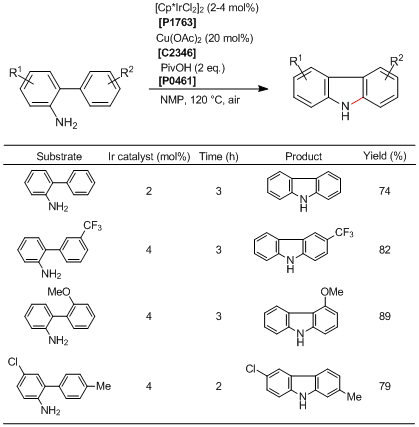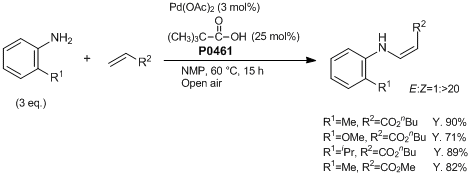Maximum quantity allowed is 999
Please select the quantity
CAS RN: 75-98-9 | 제품번호: P0461
Pivalic Acid

•본 제품의 재고는 일본 본사의 재고입니다. 주문시, 5일안에 실험실까지 도착됩니다.
•본건의 원가격은 한국 대리점의 예상 판매가격입니다.자세한 정보가 필요하시면 연락해 주십시오.( SEJIN CI Co., Ltd. (한국총대리점) 전화 : 02-2655-2480 이메일 : sales@sejinci.co.kr)
•보관 조건은 예고없이 변경 될 수 있습니다. 제품 보관 조건의 최신 자료는 홈페이지에 기재되어 있으니 양해 부탁드립니다.
•본건의 원가격은 한국 대리점의 예상 판매가격입니다.자세한 정보가 필요하시면 연락해 주십시오.( SEJIN CI Co., Ltd. (한국총대리점) 전화 : 02-2655-2480 이메일 : sales@sejinci.co.kr)
•보관 조건은 예고없이 변경 될 수 있습니다. 제품 보관 조건의 최신 자료는 홈페이지에 기재되어 있으니 양해 부탁드립니다.
규격표
| Appearance | White or Colorless to Almost white or Almost colorless powder to lump to clear liquid |
| Purity(GC) | min. 99.0 % |
| Purity(Neutralization titration) | min. 98.0 % |
| Freezing point | 32.0 to 36.0 °C |
물성치(참고치)
| mp | 34 °C |
| bp | 164 °C |
| Solubility in water | Slightly soluble |
| Degree of solubility in water | 25 g/l 20 °C |
GHS
| 픽토그램 |



|
| 신호 워드 | Danger |
| 위험물 및 유해 등록 | H302 + H312 : Harmful if swallowed or in contact with skin. H314 : Causes severe skin burns and eye damage. H371 : May cause damage to organs. H402 : Harmful to aquatic life. H290 : May be corrosive to metals. |
| 주의 사항 | P501 : Dispose of contents/ container to an approved waste disposal plant. P273 : Avoid release to the environment. P260 : Do not breathe dust/ fume/ gas/ mist/ vapors/ spray. P270 : Do not eat, drink or smoke when using this product. P234 : Keep only in original container. P264 : Wash skin thoroughly after handling. P280 : Wear protective gloves/ protective clothing/ eye protection/ face protection. P390 : Absorb spillage to prevent material damage. P308 + P311 : IF exposed or concerned: Call a POISON CENTER/doctor. P362 + P364 : Take off contaminated clothing and wash it before reuse. P303 + P361 + P353 : IF ON SKIN (or hair): Take off immediately all contaminated clothing. Rinse skin with water/shower. P301 + P330 + P331 : IF SWALLOWED: Rinse mouth. Do NOT induce vomiting. P301 + P312 + P330 : IF SWALLOWED: Call a POISON CENTER/doctor if you feel unwell. Rinse mouth. P304 + P340 + P310 : IF INHALED: Remove person to fresh air and keep comfortable for breathing. Immediately call a POISON CENTER/doctor. P305 + P351 + P338 + P310 : IF IN EYES: Rinse cautiously with water for several minutes. Remove contact lenses, if present and easy to do. Continue rinsing. Immediately call a POISON CENTER/doctor. P406 : Store in corrosive resistant container with a resistant inner liner. P405 : Store locked up. |
법규 정보
| RTECS # | TO7700000 |
운송 정보
| UN 번호 | UN3261 |
| 등급 | 8 |
| 포장 그룹 | II |
| HS 번호* | 2915.60-000 |
Application
Synthesis of N―H Carbazoles via Ir-catalyzed Intramolecular C―H Amination

Typical Procedure:
To a 20 mL two-necked flask with a reflux condenser and a rubber cap are added 2-aminobiphenyls (0.5 mmol), [Cp*IrCl2]2 (0.01 mmol, 8.0 mg), Cu(OAc)2 (0.1 mmol, 18 mg), pivalic acid (1 mmol, 102 mg), 1-methylnaphthalene (ca. 30 mg) as an internal standard, and N-methyl-2-pyrrolidone (NMP, 3 mL). Then, the resulting mixture is stirred under air at 120 °C for 3-6 h. After cooling, the reaction mixture is extracted with ethyl acetate (100 mL). The organic layer is washed by aqueous NaHCO3 (100 mL×3), and dried over Na2SO4. After evaporation of the solvents under vacuum, the product is isolated by column chromatography on silica gel using hexane-ethyl acetate (10:1) as the eluent.
To a 20 mL two-necked flask with a reflux condenser and a rubber cap are added 2-aminobiphenyls (0.5 mmol), [Cp*IrCl2]2 (0.01 mmol, 8.0 mg), Cu(OAc)2 (0.1 mmol, 18 mg), pivalic acid (1 mmol, 102 mg), 1-methylnaphthalene (ca. 30 mg) as an internal standard, and N-methyl-2-pyrrolidone (NMP, 3 mL). Then, the resulting mixture is stirred under air at 120 °C for 3-6 h. After cooling, the reaction mixture is extracted with ethyl acetate (100 mL). The organic layer is washed by aqueous NaHCO3 (100 mL×3), and dried over Na2SO4. After evaporation of the solvents under vacuum, the product is isolated by column chromatography on silica gel using hexane-ethyl acetate (10:1) as the eluent.
References
Application
Pd-Catalyzed Z-Selective Oxidative Amination of Olefins

Typical Procedure:
A mixture of butyl acrylate (128 mg, 1.0 mmol) and o-toluidine (322 mg, 3.0 mmol) is allowed to react with Pd(OAc)2 (6.7 mg, 0.03 mmol, 3 mol%) and pivalic acid (26 mg, 0.25 mmol) in NMP (0.5 mL) at 60 °C for 15 h under open air in a 30 mL round-bottomed flask. The crude reaction mixture is cooled to room temperature. EtOAc (30 mL) is added to the dark solution. The residue is purified by column chromatography on silica gel (EtOAc : Hexane = 1 : 40) to provide (Z)-butyl 3-(o-tolylamino)acrylate (210 mg, Y. 90%).
A mixture of butyl acrylate (128 mg, 1.0 mmol) and o-toluidine (322 mg, 3.0 mmol) is allowed to react with Pd(OAc)2 (6.7 mg, 0.03 mmol, 3 mol%) and pivalic acid (26 mg, 0.25 mmol) in NMP (0.5 mL) at 60 °C for 15 h under open air in a 30 mL round-bottomed flask. The crude reaction mixture is cooled to room temperature. EtOAc (30 mL) is added to the dark solution. The residue is purified by column chromatography on silica gel (EtOAc : Hexane = 1 : 40) to provide (Z)-butyl 3-(o-tolylamino)acrylate (210 mg, Y. 90%).
References
PubMed Literature
기사 / 브로셔
TCIMail
[Research Articles] Synthesis of N-H Carbazoles via Ir-catalyzed Intramolecular C-H Amination[Research Articles] Pd-Catalyzed Z-Selective Oxidative Amination of Olefins
제품문서 (분석 차트를 제공하지 못할 수도 있으니 양해 바랍니다.)
SDS
언어를 선택하십시오.
요청한 SDS를 사용할 수 없습니다.
번거롭게 해드려 죄송하지만 이 양식 보다 문의 해주십시오.
규격표
시험성적서, 각종 증명서
롯트 번호를 입력하십시오.
잘못된 로트 번호가 입력되었습니다.
샘플 시험성적서
시험성적서 샘플을 다운로드할 수 있습니다. 샘플은 반드시 최신 로트의 결과를 나타내는 것은 아닙니다.
본 제품의 샘플시험성적서는 현재 준비되어 있지 않습니다.
분석 차트
롯트 번호를 입력하십시오.
잘못된 로트 번호가 입력되었습니다.
죄송합니다만 찾으시는 분석차트는 없습니다.




